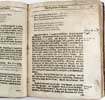Regimen Sanitatis Salerni:
OR THE SCHOOLE OF SALERNES REGEMENT of HEALTH. Containing, Most Learned and judicious Directions and Instructi-ons, for Preservation, Guide, and Government of MANS LIFE. Dedicated, Unto the late High and Mighty King of England, from that University, and published (by consent of learned Physicians) for a generall good. Reviewed, corrected, and enlarged with a Commentary for the more plain and easie understanding thereof. [two lines] By P.H. Dr, in Physicke, deceased. [one line] Whereunto is annexed, A necessary Discourse of all sorts of Fish, in use among us, with their effects appertaining to the Health of Man. As Also, Now, and never before, is added certain precious and approved Ex-periments for Health, by a Right Honourable, and Noble Personage. [one line] London, printed by B. Alsop, dwelling in Grub-Street near the Upper-Pump, 1649.
183 x 142 mm. 1fep. Title page surrounded by a thick floral border. [1] 2p Epistle Dedicatory. (x)2-206 with occasional marginalia in a fine script. 10p The Table. 207-220 Excellent and approved Receipts, 3p The Table of additional Receipts. [1] 1 fep. The whole text block uniformly browned through out. Pages 14-46 with excellent repairs not affecting the text. Original full dark brown calf with blind tooled lines on the spine and a small dark red calf label with gilt lettering. Inside and out this copy looks its age but not objectionable. A desirable copy in the original state.
- The Regimen Sanitatis Salernitanum (from Latin: Salerno Rule of Health) is a medieval didactic poem in hexameter verse written as part of the Medical School of Salerno in the XII - XIII century. Although it is commonly dated around that time, some sources argue that it dates back to 1050. The work, probably dedicated to Robert II Duke of Normandy and pretender to the English throne who was in Salerno in 1099 returning from the First Crusade. The text shows signs of the ‘School of Salerno’ for everything about hygiene, food, diet, herbs and their therapeutic properties. The author is unknown, although some attribute it to a certain Giovanni Da Milano (John of Milan), perhaps a disciple of Constantine the African; the text, however, has undergone several contributions over the centuries. It was also translated into almost all European languages, and reached nearly 40 editions before 1501, many of which were added to, or material taken away from the original version. The first English translation was made by Sir John Harington in 1608 . The first printing, containing 364 verses in Latin, was published in 1480, and annotated and edited by Arnold of Villanova; the book was enormously popular and was held in high regard as a textbook for teaching and the dissemination of medicine. It was used for that purpose until the nineteenth century, when an attempt to make a medically accurate translation was made in 1871 by the American doctor John Ordronaux. The Regimen was very popular because the rhyming verses were easy to remember. It was organized by the six ‘non-naturals’. According to Galen, they are: air, food and drink, sleeping and waking, motion and rest, excretions and retentions, and number six, dreams and the passions of the soul. The original content addressed the humors, the complexions (temperaments), and some diseases. It also contains text on phlebotomy, providing information on bloodletting. An interesting read of a far-reaching text and medieval medical classic that can also lie easily along side early cookery classics and treatises. It was not until the late 18th century that medicinal receipts, usually found at the back of most printed cookery books was fazed out.





click on image to enlarge

Antiquarian category
ref number:
11224